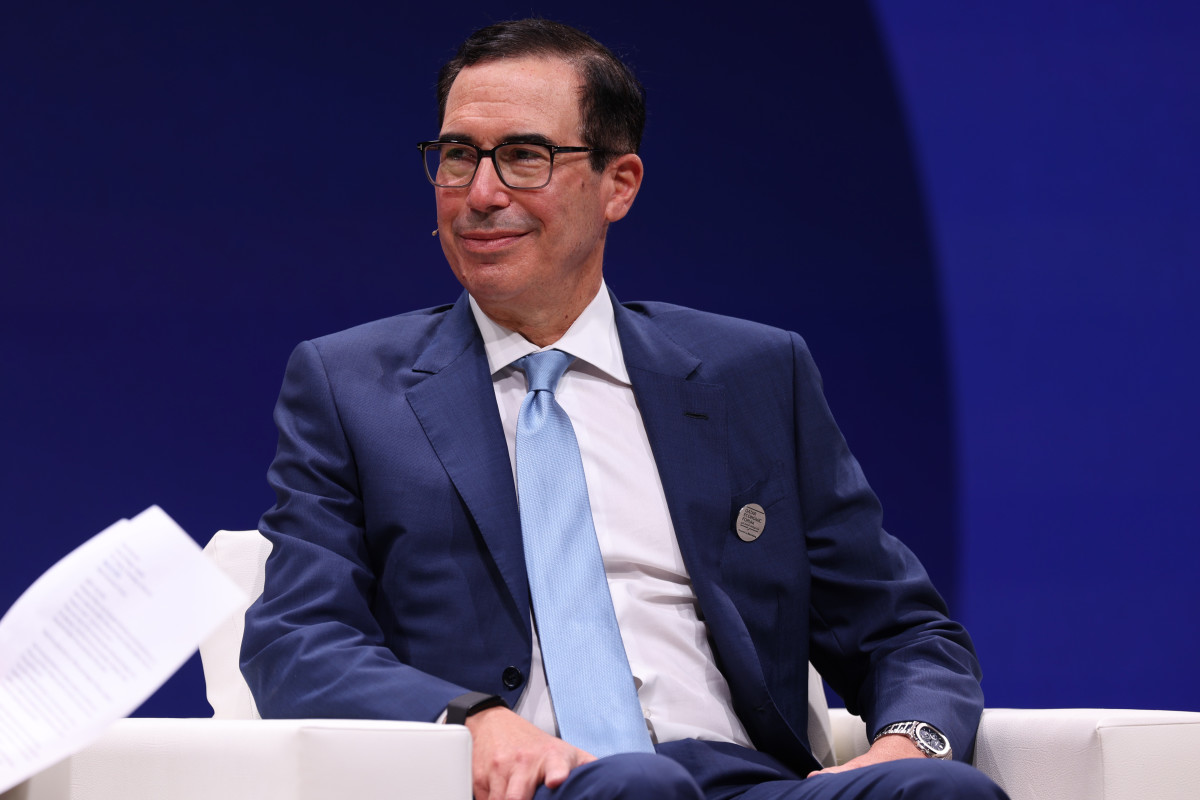
The last five weeks have been cruel to shareholders of New York Community Bancorp (NYCB) or, better, cruel to the shareholders who have hung on.
The regional bank surprised investors on Jan. 31 by reporting an unexpected fourth-quarter loss. By the end of that day shares were down 37.7%.
The situation has been volatile ever since, as the top brass at the banking company have struggled to stabilize the situation. The company had more than $110 billion in assets at the end of January.
A serious crisis, then Mnuchin happened
Wednesday the situation had turned just plain dire with the shares dropping to as low as $1.70 — representing an 83% loss from Jan. 30.
The cause was a report in The Wall Street Journal that the company was looking to raise new capital to shore up its balance sheet.
Related: Microsoft engineer says company asked him to delete an alarming discovery
But the shares rebounded sharply to as high as $4.18 in the afternoon when news broke that it had, in fact, raised $1 billion in new capital. The shares jumped to as high as $4.18 but fell back to $3.48, up 8.1% on the day.
The money is coming from an investor group led by former Treasury Secretary Steven Mnuchin and his Liberty Strategic Capital. It also includes Hudson Bay Capital, Reverence Capital Partners, Citadel Global Equities (part of the Citadel the hedge fund) and others.
Mnuchin is going on the NYCB board along with Joseph Otting, a former U.S. Comptroller of the Currency, who is now CEO of the bank (and who has long ties to Mnuchin).
Both Mnuchin's and Otting's government service was in the Trump Administration.
Also joining the board are Allen Puwalski, chief investment officer at Cybiont Capital and Milton Berlinski, head of Reverence Capital Partners. Both are in New York.
It may take a little time to see if this deal proves stable. So, anyone wanting to buy NYCB shares should go in with eyes wide open and be prepared to lose your stake.
The deal did not help the SPDR S&P Regional Banking exchange-traded fund (KRE) . The ETF which tracks regional banks, including NYCB. The ETF closed down 0.1% to $46 on a day when stocks were mostly higher.
Small Queens bank grows to operations in 7 states
The goal of the capital raise is to stabilize NYCB, which started life in 1859 as Queens County Savings Bank.
It has grown into a mostly national operation that was all organized under the Flagstar brand as of Feb. 21. The Flagstar name comes from the company's 2022 merger with Flagstar Bank of Troy, Mich.
Related: Analysts update Target stock price forecasts after earnings
NYCB now has 395 branches in New York, Michigan, New Jersey, Ohio, Florida, Arizona and Wisconsin. But it has a concentration of branches and operations in and around New York City. And in New York it has been one of the largest lenders to owners and developers of rent-controlled apartments.
The current situation came after a 24-year string of deals that saw the company acquiring 20 banks or financial companies from New York to Arizona, many with federal assistance in the aftermath of the 2008-2009 financial crisis.
Most were operations that concentrated on real estate lending, either commercial or residential loans.

Getty Images
An important deal was Flagstar Bank of Troy, Mich., a commercial bank with one of the nation's biggest mortgage serving businesses. It had experienced managers who had turned a struggling entity around.
But the last deal was probably flawed from the start. NYCB took over $38.4 billion in assets and 44 branches from Signature Bank.
Signature was one of three large banks that shockingly failed in early 2023 because of deposit runs. (The best-known of the trio was Silicon Valley Bank failed in March 2023, despite having more than $200 billion in assets. It's now part of First Citizens Bancshares of Raleigh, N.C.)
Legacy of the 2008-09 crisis
NYCB's Signature deal did two things:
- It pushed NYCB's assets above $100 billion, triggering a new and tighter regime of regulation from the Federal Deposit Insurance Corp., the Federal Reserve and the Office of the Comptroller of the Currency. It meant, among other things, NYCB had to boost its capital to pass stress tests mandated by the Fed. Capital is gold for a bank, the cushion that absorbs losses when loans go south.
- The deal also surfaced issues with its book of assets and flaws in NYCB's management systems that are proving costly and clearly sapped investor confidence.
The change in how it was going to be regulated was understood from the beginning.
The banking system recognizes two tiers of regulation: one for larger banks that need watching because of the threat a crisis can pose for the financial system and the economy.
It was an outgrowth of the 2008-2009 financial crisis that nearly toppled the global banking system and caused massive losses in the stock markets.
NYCB's woes probably not a repeat of 2008 crisis
In 2008, 2009 and 2010, 322 commercial banks failed in the United States. Between 2000 and 2007, the total was just 25. In the last 10 years: just 52, including five in 2023.
But the NYCB crisis has more to do with New York than anything else.
The asset problem was an outgrowth of understanding a new regulatory environment and begins with its New York loans.
NYCB's lending business to owners and developers of rent-controlled apartments was lucrative and stable for years.
Until 2019, the owner of a building of rent-controlled apartments could boost the rent after a vacancy by as much as 20% so an owner can recover renovation costs.
And many owners simply left the apartments vacant.
The issue has had an additional effect: It depresses the value of a property. A property's value is a function of the rents and profits.
In New York, a practice for many years was to buy a rent-controlled building and pay the tenants to leave. Then, the owner would rent the units at market rate or convert the building to high-priced condos.
Related: Top analyst revamps Tesla price target, sees potential profit surprise
The Wall Street Journal cited one case where a developer got his tenants to leave his Upper West Side building and made $85 million when he converted the property to condos. Another Upper West Side owner couldn't get the tenants to leave and sold the building at a $30 million loss.
That's NYCB's problem. It has $18 billion in loans to rent-stabilized buildings, about 20% of its loans.
The question is how much those loans are now worth. The short answer: less than before.
NYCB shocked investors when it reported a $252 million fourth-quarter loss on Jan. 31.
Things got worse on Feb. 29. The company told the Securities & Exchange Commission its fourth-quarter loss had ballooned to $2.4 billion, and its CEO and one director had resigned.
It also reported that day it had "identified material weaknesses in the Company’s internal controls related to internal loan review, resulting from ineffective oversight, risk assessment and monitoring activities."
Needless to say, investors were not amused, with the shares sinking rapidly on Friday, and with worries growing over the weekend.
Related: Veteran fund manager picks favorite stocks for 2024







